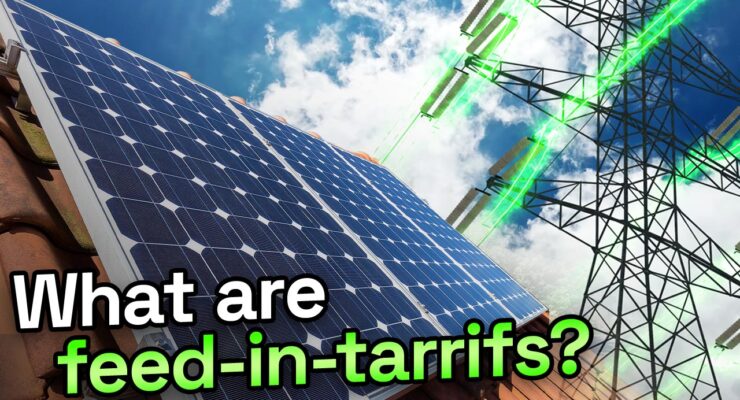Fast read
In all parts of Australia, the States and Territories have introduced feed-in tariffs (FITs) to promote renewable energy sources, including solar and wind energy.
Electricity providers must pay consumers a fixed price under a FIT scheme. The price which consumers regularly sell back is similar to the wholesale electricity price.
As a result, investment in renewable energy systems for homes or businesses is supported via this additional financial benefit.
One must be connected to the grid and generate excess renewable energy to participate in a FIT programme. Rates and eligibility restrictions may differ by state or energy retailer.
By contacting your local electricity supplier you can learn how much FIT the local company pays.
The solar feed-in tariff explained
Electricity retailers pay a feed-in tariff (FiT) to solar customers for the solar electricity that home or business users do not consume and instead export into the electricity grid.
Some states in Australia have a regulated minimum feed-in tariff, while others have a non-regulated feed-in tariff. The various State and Territory regulators can determine feed-in tariffs in Australia.
How did the feed-in tariff start?
In 2007-2008, when the solar power industry was emerging, legislators introduced Feed-in tariffs as premium payments for solar electricity. These were meant to incentivise residential and commercial electricity consumers to install and utilise solar power. Initially, it was a Gross feed-in-tariff, which meant that all generated electricity received payment.
Under a feed-in tariff system, electricity users who produce more solar energy than they use and feed it back into the grid receive a guaranteed fixed price.
The guarantee of a return on their investment encouraged consumers and business owners to invest in solar power systems and created the original demand for photovoltaic solar systems across the country. As solar panel production increased sharply and the cost of solar PV systems decreased, the need for these premium feed-in tariffs decreased.
In some states, such as New South Wales, the FiT has now reduced from 60 cents per kWh to as low as 5 -10 cents. Nevertheless, in the same timeframe, the solar panel cost has reduced from $1400 for a 175-watt panel to around $200 for a 400-watt panel. This means the price per Watt of panel reduced by a factor of 16 in less than 20 years, from $8 per watt to less than 50 cents per watt.
The feed-in tariff rates are lower today to reflect the wholesale rate that energy companies would buy electricity from the power stations.

How do FiTs work in Australia?
Feed-in tariffs are paid for electricity supplied from the home or business back to the electricity grid.
The electricity sent back to the grid is recorded by the electricity meter within your meter box. The amount of electricity exported is then reported to the electricity retailer, who will then apply a credit to the electricity bill for that electricity.
Offsetting other charges for consumption and supply service reduces the amount you need to pay to the electricity company.
Feed-in tariffs, however, are not the primary benefit of producing solar power, Solar’s primary use and advantage is for self-consumption.
Using solar power when it generates offers the best returns, as it eliminates the need to purchase electricity from your electricity retailer at their standard rates (starting at approximately 35c per kWh).
Receiving a feed-in tariff for exporting the remaining power at 5-10c provides a smaller benefit. As such, try changing your usage patterns to use more electricity during the day rather than at night for the best financial return for solar.
How can I participate in a feed-in tariff program?
Suppose you have had a solar system installed on your home by an accredited solar installer using accredited solar equipment, including solar panels and an inverter. In that case, you should automatically be eligible for a feed-in tariff via your energy retailer.
Generally, everyone connected to the grid with a residential system and producing excess renewable energy should be able to participate in a feed-in tariff scheme. However, large commercial systems sometimes face a situation where the local grid can’t handle excess exports. In these cases, they end up limiting and wasting the exported electricity, which is unfortunate.
Contacting your energy provider is always a good idea to determine if you qualify for a feed-in tariff program and learn more about the exact requirements and costs. It is also worthwhile to shop around and see who offers the lowest rate per kWh charged and the highest feed-in tariff.

Is a feed-in tariff right for me?
Suppose you are installing a solar system without batteries. In that case, a feed-in tariff offers the ability to receive an income for excess solar generated that would otherwise go to waste. So it is worth researching the feed-in tariffs available from different retailers in your area to determine the best option rate and plans for your situation.
Based on the low feed-in tariffs and your usage patterns, installing a battery storage unit to store your excess solar may be a better option for your situation to use the power during the evening peaks.
This can be particularly valuable if you are on time-of-use tariffs and your electricity provider charges around 50-60c per kWh during these periods.
Using solar electricity stored in the battery during peak periods can save you 50-60c per kWh, which is likely to make more financial sense than selling the electricity during the day and receiving only 5 to 10 cents per kWh.
To ensure you receive the best feed-in tariff for your specific region, consider installing the Solar Analytics Monitor Software. They offer a program called Plan Optimiser which will use your existing real consumption and solar generation data to calculate and recommend the best energy plan in your region.
In summary
Feed-in tariffs can be a valuable instrument for encouraging the use of renewable energy in Australia. They aid in lowering the cost of renewable energy systems and offer some financial incentives for businesses and homeowners to transition to green, sustainable sources of electricity.
Nevertheless, nowadays, the main benefit of installing a solar system is self-consumption.
Therefore, we should prioritise self-consumption when installing solar power and consider feed-in tariffs only as a minor additional income stream from solar.
Be sure to check with online electricity price comparison websites to determine what feed-in tariff options are available in your area. Sometimes your local installer can also recommend the best local deal.



